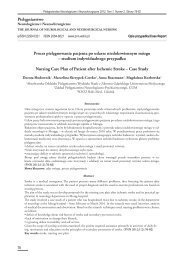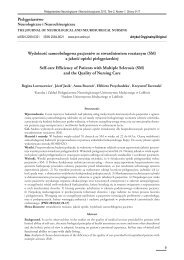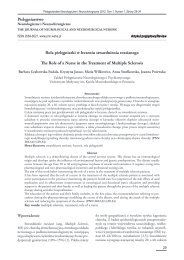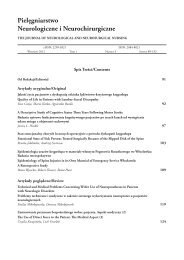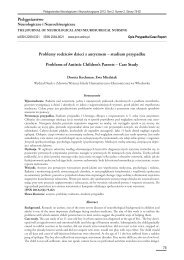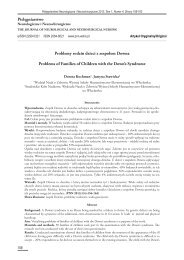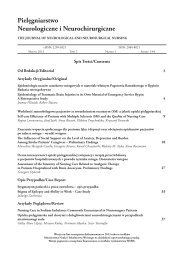3 - PNN - Wyższa SzkoÅa Humanistyczno-Ekonomiczna
3 - PNN - Wyższa SzkoÅa Humanistyczno-Ekonomiczna
3 - PNN - Wyższa SzkoÅa Humanistyczno-Ekonomiczna
You also want an ePaper? Increase the reach of your titles
YUMPU automatically turns print PDFs into web optimized ePapers that Google loves.
Kaya et al. / <strong>PNN</strong> 2013, Tom 2, Numer 3, Strony 96-103<br />
should be made after the surgery until the patient is<br />
discharged.<br />
In international and community-based studies,<br />
the incidence of constipation has been shown to be<br />
twice as many in women than men [5,7,13,20-22]. In<br />
this study, both average CRAS and CSI scores of women<br />
and were found to be higher than men. This result<br />
is in line with other studies, and suggests that female<br />
hormones increase the risk of constipation.<br />
Increasing age is effective on the prevalence and<br />
severity of constipation as well as chronic diseases. In<br />
old age, endocrine disorders, neurological diseases, depression<br />
and urinary incontinence are commonly seen<br />
and drug use associated with these diseases increases.<br />
In addition, in elderly people, a decrease in intestinal<br />
peristalsis, abdominal muscle elasticity and mucus secretion<br />
is seen [2]. In studies conducted, it has been<br />
seen that constipation gradually increases after the age<br />
of 65 and the biggest increase is at the age of 75 [20].<br />
This study also showed an increased risk of constipation<br />
with age.<br />
There is a close relationship between motion and<br />
intestinal peristalsis. There is proportional relationship<br />
between the emergence of the problem of constipation<br />
and lack of movement or extension of time spent in<br />
bed. Harari [23], supports the idea of immobility being<br />
a primary risk factor, especially in elderly people.<br />
However, in 1993 Resende et. al. [24], showed no effect<br />
with increased walking but, using a combined approach<br />
of activity and diet, found reduced laxative use<br />
in elderly patients [25]. Klauser et al [26], stated there<br />
was no evidence that constipated patients drank less<br />
fluid or took less exercise than healthy subjects.<br />
In this study, it was found that those who have<br />
sedentary lifestyle and those who do not exercise regularly<br />
have higher CRAS and CSI scores. This result<br />
showed that especially the early postoperative mobilization<br />
is very important in the prevention of constipation.<br />
The common belief that people must have a daily<br />
bowel movement has led to self-medicating with laxative<br />
products. Although people may feel relief when<br />
they use laxatives, typically they must increase the dose<br />
over time because the body grows reliant on laxatives<br />
in order to have a bowel movement. As a result, laxatives<br />
may become habit-forming [26,27]. Similar to<br />
the knowledge in the literature, in this study, those<br />
who use laxatives have higher CSI and CRAS scores.<br />
In the literature, it is emphasized that drugs such<br />
as antidepressants, antispasmodics, diuretics, anticonvulsants<br />
and analgesic drugs increase the risk of constipation<br />
[2]. Also, Hassouneh et al. [28] in a study on<br />
pain management in craniotomy patients found that<br />
66% of patients had a side effect of constipation. In<br />
this study, it was observed that individuals who used<br />
analgesic drugs on the 3 rd day of surgery and on discharge<br />
had high constipation risk. This result suggested<br />
reducing especially the use of opioid analgesic for pain<br />
management as much as possible, trying out alternative<br />
pain management techniques.<br />
Conclusions<br />
Constipation risk of patients in neurosurgery clinics<br />
is at a considerable level. For this reason, in order<br />
to give integrative care, nurses need to make detailed<br />
diagnostic in terms of pre-operative and post-operative<br />
constipation risk and choose appropriate interventions<br />
for the individual and implement them.<br />
Implications for nursing practice<br />
As this study shows that 40.7% of the patients<br />
on the 3 rd day of surgery and 32.5% of the patients at<br />
discharge were determined to be in mid-and high-risk<br />
groups in terms of constipation, it makes it a very important<br />
challenge for nurses to develop relevant initiatives<br />
in order to reduce the number of patients having<br />
postoperative constipation. A controlled study is needed<br />
to test the effect of an approach that can be practical<br />
at the patients during the hospital stay.<br />
Acknowledgements<br />
We are grateful to Istanbul University Unit of<br />
Scientific Research Projects (IUBAP) for their invaluable<br />
contributions to the study (Project No: 17887).<br />
*This study has been supported by Istanbul University<br />
Unit of Scientific Research Projects (Project No: 17887)<br />
This sentence is removed<br />
References<br />
[1] Kaya N. Yaşam modeli. In Babadağ K., Aştı T.A. (Ed.),<br />
Hemşirelik esasları uygulama rehberi. İstanbul Medikal<br />
Yayıncılık, İstanbul 2008;1-7.<br />
[2] Kaya H. Bağırsak boşaltımı ve gastric entübasyon.<br />
In Aştı T.A., Karadağ A. (Ed.), Klinik uygulama becerileri<br />
ve yöntemleri. Adana Nobel Kitabevi, Adana<br />
2011;1116-1136.<br />
[3] McCrea G.L., Miaskowski C., Stotts N.A., Macera<br />
L., Paul S.M., Varma M.G. Gender differences in<br />
self-reported constipation characteristics, symptoms,<br />
and bowel and dietary habitsamong patients attend-<br />
102



